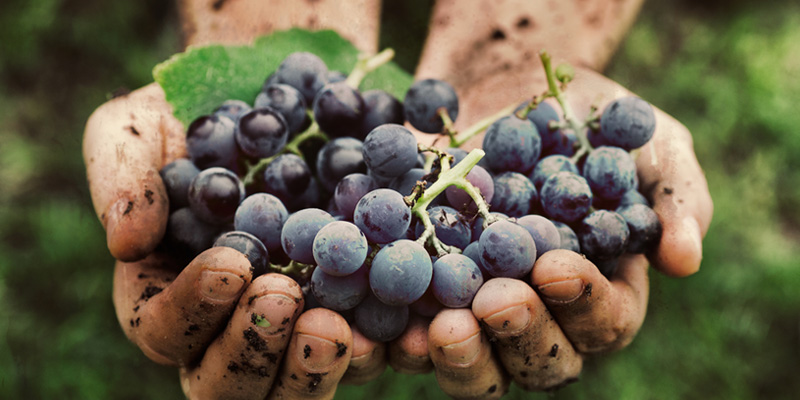
You may have heard the term “natural wine” floating around. It’s not a new trend, though it seems to be getting more and more entrenched in mainstream wine-drinking culture. So we thought we’d break it down for you.
Since the green movement of the late ’90s, we have gone through a few phases in wine. First came the market demand for organic wine. As that trend plateaued, consumers began to seek out biodynamic wine. Those trends transformed into natural wine. Since 2009, natural wine has been on the rise, though it’s only in the past few years that it really hit the fever pitch it’s at today.
So what is natural wine? Natural wine is an umbrella term; it’s an ideal used to describe wine utilizing organic or biodynamic practices. The winemaker’s focus is to intervene as little as possible. Essentially, the winemaker wants a natural wine to make itself. This could mean letting weeds grow in your vineyard to maintain and encourage biodiversity, or it could mean letting your wine begin to ferment with the native yeasts in the air instead of buying cultured yeasts. The biggest trend in this style of winemaking is not adding any sulfites to the wine. Sulfites are a natural stabilizing agent that helps preserve wine for export and shelf life. Basically, with natural wine, nothing is entered into the process and nothing is taken out. Grow and go, if you will. In addition to all this, the winemakers producing wine in this style are concerned with sustainability. They profess to be more in tune with Mother Nature, letting her guide the winemaking process by respecting the land under vine.
The result is a fun new wine category to explore. These wines can have unique aromas and characteristics that you may not be used to. They also give you a sense of how wine was made before modern technology was introduced into the mix. The great natural wines can be straight-up invigorating, seeming alive on the palate. I have had some natural wines that physically affected me, making me want to do back flips (I didn’t, though, because I can’t do back flips).
But making wines this way does have potential consequences for the wines as well as the consumer. Just like any other wine category, there are the good, the bad, and the ugly. Because of the non-interventionist way the wines are made, they can be very unstable, especially when winemakers do away with sulfites. You can end up with a swampy stank, which cannibalizes any subtle aroma and comprises the structural balance of all the elements that make up the body. They can also be a bit cloudy.
Another downside for the consumer may be that these wines are made in smaller quantities. They are also more labor- intensive. Because of this, and because of their potential instability, the distribution of “natural” wines is not as wide, which in turn affects the cost. They can be pretty expensive; the price point on these wines often starts at $20 and quickly jumps up from there. They can be a little steep for the everyday wine lover.
So when getting into these wines, be aware of what you are about to experience. Most are not your usual polished wines with seamless character integration. Most have a significant separation of flavor due to the way they are made. There is much more organic material in these wines, and even if they see a bit of oak, it doesn’t do enough to soften some of them for reds. Whites are about as different as you can get; they are often fuller-bodied, especially if they are orange wines with more tannins than you might be used to. So dive in and open your mind. Here are a few great ones at the lower price range to get you started. They are guaranteed to be balanced and a good starting point.
2011 Kabaj Rebula, Goriška Brda, Slovenia, $20-$25
This is an orange wine that has a beautiful amber color with subtle notes of apricot and a whisper of peach. The best part about this wine is the herbal tones that balance the fruit. Open this when it is slightly chilled and let it sweat. The wine really soars when it comes to almost room temperature. This a great wine with light meats and cheese.
Foradori Teroldego Rotaliano,Trentino, Italy, $15-$25
Here is a more affordable natural wine that also has softer vibes than most and a unique flavor profile. Teroldego Rotariano is a native grape to the Trentino region in northern Italy. If you like Merlot, this is a great wine for you; it’s a soft, chewy, medium-bodied red with berry notes along with a waft of hazelnut. It is balanced by great acidity, which brightens up the wine a bit, giving it slight pomegranate notes as well.
Donkey and Goat Grenache Blanc, Sierra Foothills, California, USA, $20-30
This one is a great full-bodied white wine. It’s round and rich with just enough acidity to keep it refreshing, with notes of pear and hints of tropical fruit. This wine has a nice deep texture to it with a little bit of comfortable weight on the palate. It is technically an orange wine, but you wouldn’t know it from looking at it. It is skin-fermented like a red, which gives it its depth.

